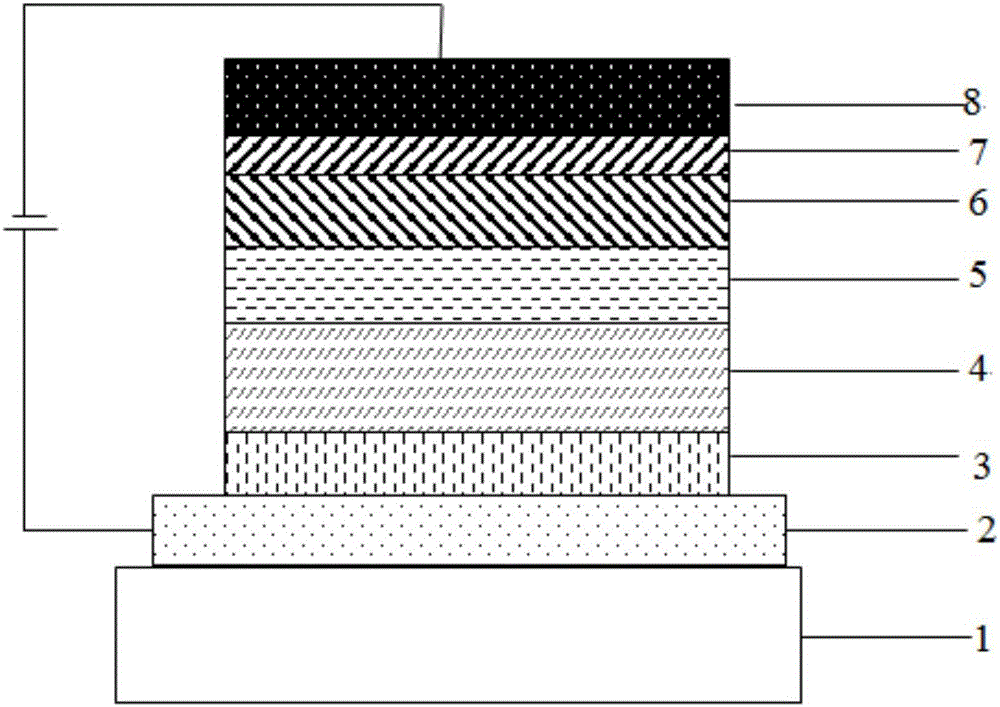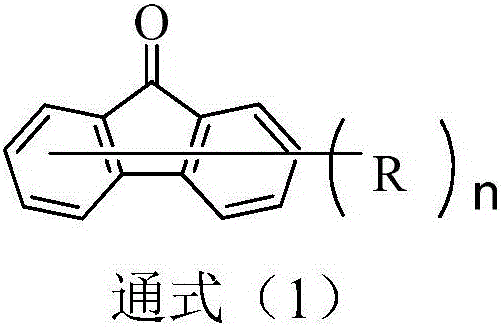Compound with 9-fluorenone as nucleus and application of same to OLED device
A compound, boric acid compound technology, applied in the semiconductor field, can solve the problems of efficiency roll-off, low S1 state radiation transition rate, difficult exciton utilization rate and high fluorescence radiation efficiency
- Summary
- Abstract
- Description
- Claims
- Application Information
AI Technical Summary
Problems solved by technology
Method used
Image
Examples
Embodiment 1
[0063] Embodiment 1: the synthesis of compound 35:
[0064] synthetic route:
[0065]
[0066] In a 250mL three-neck flask, under a nitrogen atmosphere, add 0.01mol 2-bromo-9-fluorenone, 0.015mol intermediate A1, 0.03mol sodium tert-butoxide, 1×10 -4 molPd(dppf)Cl 2 , 180mL toluene, heated to reflux for 10 hours, sampled and spotted, the raw materials were completely reacted; naturally cooled to room temperature (20-25°C), filtered, and the filtrate was collected for vacuum rotary evaporation (-0.09MPa, 85°C), and column chromatography , the target product was obtained, the HPLC purity was 99.2%, and the yield was 74.7%.
[0067] Elemental analysis structure (molecular formula C 49 h 36 N 2 O): Theoretical C, 87.99; H, 5.43; N, 4.19; O, 2.39; Tested: C, 87.98; H, 5.45; N, 4.20;
[0068] HPLC-MS: The theoretical molecular weight of the material is 668.82, and the measured molecular weight is 669.04.
Embodiment 2
[0069] Embodiment 2: the synthesis of compound 37:
[0070] synthetic route:
[0071]
[0072] In a 250mL three-neck flask, under a nitrogen atmosphere, add 0.01mol 3-bromo-9-fluorenone, 0.015mol intermediate B1, 0.03mol sodium tert-butoxide, 1×10 -4 molPd(dppf)Cl 2 , 180mL toluene, heated to reflux for 10 hours, sampled and spotted, the raw materials were completely reacted; naturally cooled to room temperature (20-25°C), filtered, and the filtrate was collected for vacuum rotary evaporation (-0.09MPa, 85°C), and column chromatography , the target product was obtained, the HPLC purity was 99.4%, and the yield was 76.3%.
[0073] Elemental analysis structure (molecular formula C 46 h 30 N 2 O): Theoretical C, 88.15; H, 4.82; N, 4.47; O, 2.55; Tested: C, 88.14; H, 4.84; N, 4.46;
[0074] HPLC-MS: The theoretical molecular weight of the material is 626.74, and the measured molecular weight is 626.96.
Embodiment 3
[0075] Embodiment 3: the synthesis of compound 48:
[0076] synthetic route:
[0077]
[0078] In a 250mL three-neck flask, under a nitrogen atmosphere, add 0.01mol 2-bromo-9-fluorenone, 0.015mol intermediate C1, 0.03mol sodium tert-butoxide, 1×10 -4 molPd(dppf)Cl 2 , 180mL toluene, heated to reflux for 10 hours, sampled and spotted, the raw materials were completely reacted; naturally cooled to room temperature (20-25°C), filtered, and the filtrate was collected for vacuum rotary evaporation (-0.09MPa, 85°C), and column chromatography , the target product was obtained, the HPLC purity was 99.1%, and the yield was 78.6%.
[0079] Elemental analysis structure (molecular formula C 43 h 23 NO 3 ): theoretical value C, 85.84; H, 3.85; N, 2.33; O, 7.98; test value: C, 85.85; H, 3.86; N, 2.32;
[0080] HPLC-MS: The theoretical molecular weight of the material is 601.65, and the measured molecular weight is 601.88.
PUM
| Property | Measurement | Unit |
|---|---|---|
| Thickness | aaaaa | aaaaa |
Abstract
Description
Claims
Application Information
 Login to View More
Login to View More - R&D
- Intellectual Property
- Life Sciences
- Materials
- Tech Scout
- Unparalleled Data Quality
- Higher Quality Content
- 60% Fewer Hallucinations
Browse by: Latest US Patents, China's latest patents, Technical Efficacy Thesaurus, Application Domain, Technology Topic, Popular Technical Reports.
© 2025 PatSnap. All rights reserved.Legal|Privacy policy|Modern Slavery Act Transparency Statement|Sitemap|About US| Contact US: help@patsnap.com



